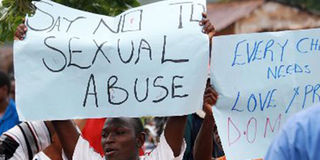Sexual abuse among pupils common, new report shows

Members of the public protest against a resident who is accused of child defilement, on March 14, 2014. A report says the perpetrators of sexual harassment and abuse are predominantly the children themselves. FILE PHOTO | LABAN WALLOGA | NATION MEDIA GROUP
What you need to know:
- The survey of 2,010 pupils in 79 public schools by Dr Sarah Ruto of Women Educational Researchers of Kenya (WERK), found that nearly six in 10 children are verbally abused by their peers using words with sexual connotation.
- It cites the most popular insults as those referring to private parts and words such as “foolish”, “stupid”, “idiot”, “mad” and “dog”.
Primary school children are routinely subjected to verbal, physical and sexual abuse, according to a new report.
Often, pupils suffer sexual harassment from their schoolmates and in some cases beat up their teachers, according to the report that describes school-based violence as institutionalised.
The survey of 2,010 pupils in 79 public schools by Dr Sarah Ruto of Women Educational Researchers of Kenya (WERK), found that nearly six in 10 children are verbally abused by their peers using words with sexual connotation.
It cites the most popular insults as those referring to private parts and words such as “foolish”, “stupid”, “idiot”, “mad” and “dog”.
The perpetrators of sexual harassment and abuse are predominantly the children themselves, says the report.
“The combined statistic of children reporting as having been sexually harassed either by a schoolmate or a friend (assuming that the friend was a peer) totalled to 43 per cent mentions, followed by strangers (17 per cent) and friends (12 per cent), while family members stood at eight per cent,” states the How Safe Are Our Children? report.
Some pupils, identified as the big boys, in Meru, Lodwar and Isiolo are prone to attacking their teachers physically and verbally.
While most of the abuse is verbal, there are case of pupils beating up teachers or attacking them with knives.
Eight in every 10 children have been beaten with a stick, rod, belt or plastic slippers. Other examples of abuse mentioned by the respondents took the form of being kicked, slapped, punched or pinched, as well as being scalded with water or burnt with a hot rod.
Many of these forms of abuse take place at the hands of parents or guardians at home.
Teachers account for 24 per cent of the violence, followed by schoolmates (19 per cent), parents (20 per cent) and friends (14 per cent).
“Followed by verbal abuse faced by seven out of every 10 children, three out of 10 children have been sexually harassed and two out of 10 sexually abused,” says the report, which points out that more girls than boys reported having been victims of abuse.
SOLUTION
While the most cited venue of violence is the home, followed by the school, the trip to and from school is where sexual offences happen the most, says the report, which attributes the violence to destabilisation of the family unit through death, separation, divorce or single parenthood and effects of domestic violence, alcohol abuse and parental neglect.
Others are inefficient ways of reporting, weak law enforcement and unfriendly school practices.
It suggests removal of gender stereotypes at home and in the community, introduction of counselling in the school curriculum, gender training to curb bias and establishment of child protection desks and rescue centres.
Dr Ruto made the presentation at the Catholic Private Educational Institutions Conference that ends Friday.
The study was commissioned by the Kenya Catholic Secretariat Commission for Religious Education.




